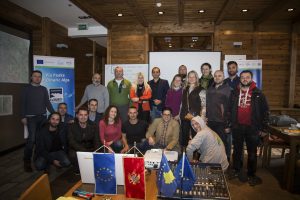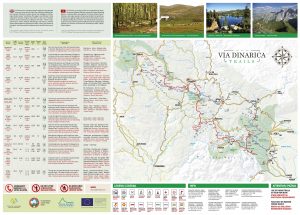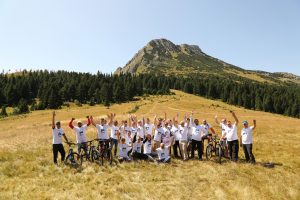Interview by ATTA member and AdventureEDU Educator Kirsi Hyvaerinen, PRÁTTO Consulting, Montenegro.

At the end of the 2017 summer season, the closing event of the cross border project “Via Peaks of Dinaric Alps - ViP Dinarica," along the long distance trail Via Dinarica was held at the Mountain Lodge “Grope" on the Hajla Mountain in Rožaje, Montenegro. The leader of the project, Svetlana Vujičić, Director of the Centre for Sustainable Tourism Initiatives (CSTI), answered a few questions on what´s new and exciting for adventure travelers between Montenegro and Kosovo.
The main partners of the project for the past 1.5 years have been the Mountaineering Association of Montenegro (PSCG), the Community Development Fund (CDF) and Orienteering Club “Prishtina" of Kosovo. The group has established new adventure travel products, consisting of two continuous trails and new services for hiking and biking in a length of 600 km (370 miles). These trails connect three National Parks in Montenegro – Durmitor, Biogradska Gora and Prokletije with the National Park Bjeshket e Nemuna / Prokletije in Kosovo. The project contributed to the integration of tourist offers of four National Parks and development of rural mountain communities.
In this cross border area the new and growingly recognizable brand of “Via Dinarica" was shaped further.
Q: Back in 2011, CSTI was the first organization to begin mapping, connecting and implementing the “Via Dinarica” between Montenegro, Bosnia and Hercegovina, and now between Montenegro and Kosovo. Why is it important to have this trail and “development corridor” in this region?
A: This project added a 600 km (370 miles) extension to the Via Dinarica (which connects Sutjeska (BiH) and Durmitor (MNE) National Parks along 310 km - 192 miles of biking and hiking trails) running east into Kosovo via “Peaks of the Balkans” and further into Albania. By bringing Kosovo and Albania on board and stretching for 1,000 km (620 miles) through Bosnia and Herzegovina, Montenegro, Kosovo and Albania, the Via Dinarica mega trail will be a step towards the world’s “must-do treks” along with the Via Alpina, the Inca Trail and the Appalachian Trail. Thus, providing new opportunities on each side of the borders.

This continuous hiking and biking mega trail passes through 6 National Parks, numerous authentic villages and municipalities with an exciting variety of breath taking landscapes. Visitors are treated to a wide range of activities, natural beauties, traditional products and the unique cultural heritage. The project has raised awareness for good business practices and environmental protection, and it links stakeholders in the region towards sustainable economic development.
Q: According to your experience, what would be the best way to stabilize the common future development of “Via Dinarica" from Slovenia through Albania?
A: To achieve the mission of this trail, it is crucial to get the stakeholders around one table to discuss the vision of where the region is heading in the future, to develop products that will satisfy future clients, and create linkages among SMEs. This role should be taken by the key stakeholders from the whole region who are involved in the development of Via Dinarica. Together, we should work on the following:
Determination of the exact geographic area of the trail. This includes a mix of rural and urban environments, where special interest points are chosen, as well as stops where travelers can get more information.
Unified branding for the whole trail, with a “one source of truth” web portal.
Experiences and products, such as:
- Natural and cultural heritage locations (monasteries, national parks, rivers, canyons, lakes)
- Responsible tourism based activities
- Cultural and culinary – traditional arts, crafts, home-made food products and similar
- Accommodation, food and drink providers (hotels, guest-houses, B&B´s, restaurants, small guest houses, offering accommodation, food, and light outdoor activities)
Cross-border tourism itinerary development covering mountain based trails (hiking and biking) throughout the region. This is very important to strengthen the stakeholders' networking and conditions for increasing tourist visits for extended stays in the area, i.e. putting focus on positive local impacts.
Q: What activities, within this project, have made a difference to future adventure travelers and tour operators?
A: Our baseline will enable more effective action of tour operators towards further creation of attractive offers in this region.
In the past 18 months, we have:
- Finished the basic development of the “Via Dinarica" concept in this rather unknown area.
- Improved mountain tourism infrastructure such as marking, signposting, placement of resting places and info boards with insight to overall and specific characteristics of the trails.
- Provided product development, marketing and cooperation trainings to 40 small businesses and Local Tourism Organisations and 40 outdoor professionals.
- In workshops with the Steering Group, we have created universal understanding for the marketing and maintenance needs.
- Created guides and maps, immediately available via tourism operators and tourism info centers in the region, outdoor clubs and the National Parks.
- Organised promotional events; an 8-day familiarization trip and half day inauguration of the biking trail for the citizens and tourism professionals in this region.

A: As the Via Dinarica is a literal case of cross- border partnerships, CSTI will continue to tailor similar projects with strategic initiatives needed to economically regenerate the region while developing and diversifying tourism products and linking private and public sector. Apart from economic benefits it is very important to consider environmental and social impacts and benefits of the region, to help make the communities more attractive places to live and visit.
There is good synergy between “Via Dinarica" and the “Peaks of the Balkans" because it will be possible to connect over 1,000 km (620 miles) of continuous trails – both hiking and biking - connecting Bosnia and Hercegovina, Montenegro, Kosovo[1] and Albania.
We will continue to support new ideas in sustainable tourism development and better cooperation in this whole region.
The overall project value in Montenegro amounts to 220.727 EUR, out of which 84.4% is funded by the EU, through first IPA Cross – Border Cooperation Programme Montenegro – Kosovo. The project implementation started in March 2016 and lasted 18 months.
[1]This designation is without prejudice to positions on the status, and in line with UNSCR 1244/1999 and the ICJ Opinion on the Kosovo declaration of independence.
